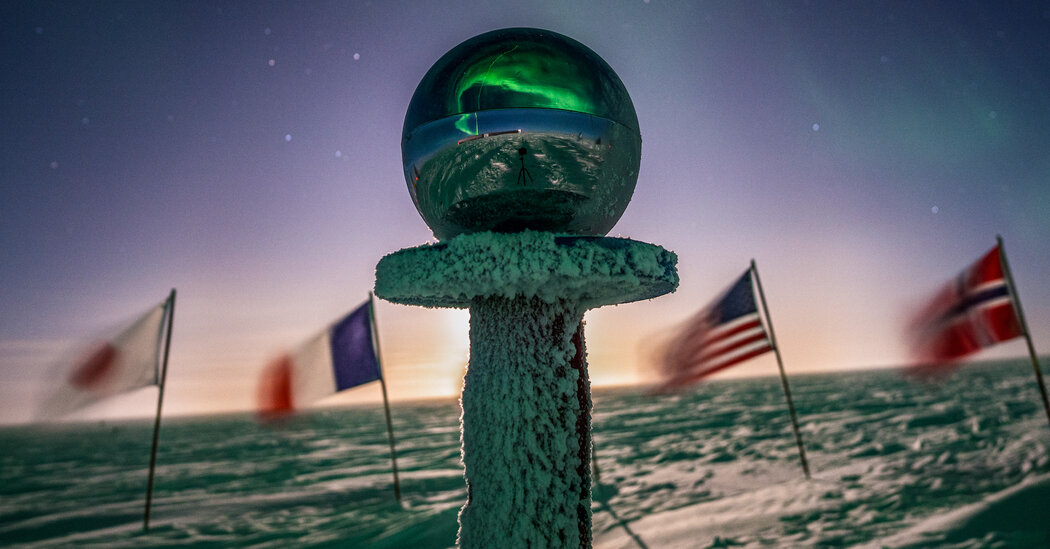Kelly Brunt wasn’t the only federal employee to be laid off this month while traveling for work. But she was almost certainly the only one whose work trip was in Antarctica.
Dr. Brunt was a program director at the National Science Foundation, the $9 billion agency that supports scientific advancement in practically every field apart from medicine. As part of the Trump administration’s campaign to shrink the federal government, roughly 10 percent of the foundation’s 1,450 career employees lost their jobs last week. Officials told staff members that layoffs were just getting started.
Yet the office where Dr. Brunt worked has an importance that goes beyond science.
The Office of Polar Programs coordinates research in the Arctic and Antarctic, where the fragile, fast-changing environments are of growing strategic interest to the world’s superpowers.
By treaty, Antarctica is a scientific preserve. And for decades, U.S. research — plus the three year-round stations, the aircraft and the ships that support it — has been the bedrock of the country’s presence there.
Of late, though, “countries such as Korea and China have been rapidly expanding their presence, while the U.S. has been sort of maintaining the status quo,” said Julia Wellner, a marine scientist at the University of Houston who studies Antarctic glaciers.
The Office of Polar Programs has long been understaffed, said Michael Jackson, who worked as an Antarctic program director for the agency until retiring late last year. Aging planes and facilities, plus flat budgets for science, have snarled the pace of research. “Right now we are capable of doing maybe 60 percent of the science that we were capable of doing” 15 years ago, Dr. Jackson said.
If the Trump administration slashes science funding, American researchers could collaborate more with other nations’ polar institutes, as many already do, Dr. Wellner said. “But those other countries have their own scientists,” she said. “I don’t think South Korea or the U.K. is just going to make room for all of us.”
When asked how the layoffs of polar scientists would affect the National Science Foundation’s work, an agency representative declined to comment.
When the agency fired Dr. Brunt and other employees last week, she was heading home after spending over a month at McMurdo Station in Antarctica. Another program director who was laid off, David Porter, had been supporting scientists embarking from New Zealand on a 10-week expedition in the Southern Ocean. Other teams were gearing up to drill ice cores, take seismic measurements, measure ultraviolet radiation and more.
Foundation program officers help decide which projects like these are most worthy of federal funding. Often they are seasoned scientists themselves: Dr. Porter is an expert in atmospheric and oceanic science who has worked at Columbia University.
Dr. Brunt’s N.S.F. employment was probationary because she became a permanent worker only six months ago, she said. Before that, she spent three years at the agency on temporary assignment from NASA and the University of Maryland. In total, she has 25 years of experience as a glaciologist and 15 Antarctic field seasons under her belt.
“I want to dispel this rumor that this is a bunch of people who are sitting around sucking off the government milk bottle,” Dr. Jackson said. “These are people that had well-established careers in academia, and they decided that they wanted to come to N.S.F. and give something back to the U.S. taxpayers.”
Dr. Jackson also doesn’t buy the idea that eliminating federal workers will root out fraud and abuse. “By removing the program officers at the front lines, you’re actually removing the very thing that you want to have there in place to make sure that no fraud and abuse is happening,” he said.
For scientists in the field, their program officer might also be their first point of contact when issues arise, said Twila Moon, the deputy lead scientist at the National Snow and Ice Data Center in Boulder, Colo.
“Maybe you’re having trouble with some of the logistics,” Dr. Moon said. “Maybe your instruments aren’t getting to you on time, or there’s been changes in the field flights that you need to think about.” Fewer officers mean more scientists at risk of snags or challenges, she said.
The geopolitical significance of Antarctica might help shield it from the administration’s most severe cost-cutting, said Dawn Sumner, a planetary scientist at the University of California, Davis, who studies microbes in Antarctic lakes. “The only way you can have a presence in Antarctica is through science,” Dr. Sumner said.
Even so, much of that science is motivated by the need to address human-caused global warming, a subject that President Trump and his allies have long denigrated as a nonissue.
Dr. Wellner of the University of Houston finds it “appalling” that Antarctic scientists might someday have to avoid mentioning climate change to receive federal funding. Still, she said, researchers in Texas, Florida and other states long ago figured out how to sidestep official taboos around climate.
“We talk about sea-level rise in Texas all the time,” Dr. Wellner said. “You don’t have to talk about ‘climate.’ It’s just ‘sea-level rise.’”


